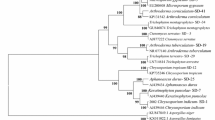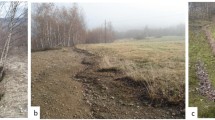Abstract
In order to determine which species of geophilic dermatophytes were present in Western Australian soils 299 samples were investigated. These samples were collected from a range of locations, 208 from towns throughout the state and 91 samples from the Perth Metropolitan area.
Most samples were collected from areas frequented by people and animals, such as home gardens, parks and animal yards.
Of the total 299 soils, 271 (90.6 %) yielded keratinophilic fungi. A total of 181 dermatophytes were isolated, and there were 205 isolations of other keratinophilic fungi.
Microsporum gypseum (30.7 %) was the most prevalent dermatophyte recovered from soil followed byMicrosporum cookei (21.7 %) and thenTrichophyton ajelloi (8.0 %). No other dermatophytes were recovered.Chrysosporium indicum was the most common of all the keratinophilic fungi and was isolated from 50.1 % of the samples. Mixed growth was obtained from 33.5 % of the soil samples.
Similar content being viewed by others
References
Ajello, L. 1953. The dermatophyte, Microsporum gypseum, as a saprophyte and parasite. J. Invest. Derm. 21: 157–171.
Ajello, L. 1956. Soil as a natural reservoir for human pathogenic fungi. Science. 123: 876–879.
Al-Doory, Y. 1968. The isolation of keratinophilic fungi from African soils. Mycopath. et Mycol. Appl. 36: 113–116.
Alteras, I. & R. Evolceanu. 1969. A ten year survey of Romanian soil screening for keratinophilic fungi (1958–1967). Mycopath. et Mycol. Appl. 38: 151–159.
Balabanoff, V.A. & P. Usunov. 1967. Organic waste matter of plant origin-natural source of primitive dermatophytes. I Communication. Mycopath. et Myco. Appl. 33: 43–48.
Blaschke-Hellmessen, R. 1969. Verbreitung keratinophiler bodenpilze im Dresdener raum in abhängigkeit vom pH wert des standortes. (Distribution of keratinophilic soil fungi in the Dresden area depending on the pH value of the site). Mykosen 12: 551–556.
Böhme, H. & H. Ziegler, 1969. The distribution of geophilic dermatophytes and other keratinophilic fungi in relation to the pH of the soil. Mycopath. et Mycol. Appl. 38: 247–255.
Chmel, L., A. Hasilikova, J. Hrasko. & A. Vlacilikova. 1972. The influence of some ecological factors on keratinophilic fungi in the soil. Sabouraudia. 10: 26–34.
Dawson, C.O., J.C. Gentles, & E.M. Brown. 1964. Environmental conditions affecting sexual reproduction in species of Arthroderma and Nannizzia. Sabouraudia 3: 245–250.
Donald, G.F. & G.W. Brown, 1962. Microsporum gypseum and Keratinomyces ajelloi in South Australia. Aust. J. Derm. 6: 258–262.
Dunne, R.M. & R.J. Morahan. 1964. The occurrence of keratinophilic fungi in Queensland. Mycopath. et Mycol. Appl. 22: 343–349.
Durie, E.B. & D. Frey. 1962. The presence of dermatophytes and other keratinophilic fungi in soils. Aust. J. Derm. 6: 167–171.
Frey, D. 1971. Isolation of Microsporum cookei from a human case. Sabouraudia 9: 146–148.
Garg, A.K. 1966. Isolation of dermatophytes and other keratinophilic fungi from soils in India. Sabouraudia 4: 259–264.
Georg, L.K., W. Kaplan, L. Ajello, W.M. Williamson & E.B. Tilden. 1959. The parasitic nature of the soil fungus Keratinomyces ajelloi. J. Invest. Derm. 32: 539–544.
Mariat, F. & G. Tapia. Observations sur une souche de Microsporium cookei parasite du Cynocephale (Papio Papio). Sabouraudia 5: 43–45.
Marples, M.J. 1965. The distribution of keratinophilic fungi in soils from New Zealand, and from two Polynesian Islands. Mycopath. et. Mycol. Appl. 25: 361–372.
McGinnis, M.R. & A.E. Hilger. 1972. Growth of Trichophyton mentagrophytes on natural substrates. Sabouraudia 10: 230–236.
Muhammed, S.I. & N. Lalji. 1978. The distribution of geophilic dermatophytes in Kenyan soils. Mycopathologia 63: 95–97.
Otcenasek, M., K. Hudec, Z. Hubalek & J. Dvorak. 1967. Keratinophilic fungi from the nests of birds in Czechoslovakia. Sabouraudia. 5: 350–354.
Palsson, G. 1968. Geophilic dermatophytes in the soil in Sweden. Studies on their occurrence and pathogenic properties. Acta. Vet. Scand. (Supp. 25). 9: 5–89.
Presbury, D.G.C. & C.N. Young. 1978. Trichophyton ajelloi isolated from a child. Sabouraudia. 16: 233–235.
Sabouraud. R. 1894. Les trichophyties humaines. Reuff et Cie, Paris.
Vanbreuseghem, R. 1952. Technique biologique pour i'solement des dermatophytes du sol. Ann. Soc. Belg. Med. Trop. 32: 173–178.
Author information
Authors and Affiliations
Rights and permissions
About this article
Cite this article
McAleer, R. Investigation of keratinophilic fungi from soils in Western Australia a preliminary survey. Mycopathologia 72, 155–165 (1980). https://doi.org/10.1007/BF00572658
Issue Date:
DOI: https://doi.org/10.1007/BF00572658




